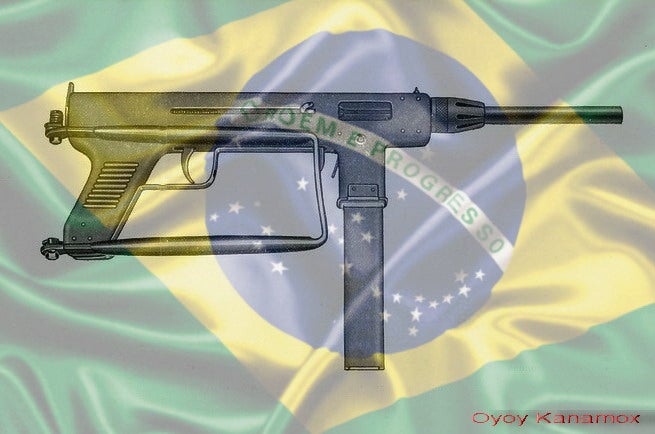While still under the effect of the strong wake created by the flood of new, eye-catching SHOT 2018 products, this old scribe was somehow motivated to once again write on older, lesser-known stuff. The chosen subject was the INA submachine gun. Very well known in Brazil due to decades of use by the local armed and police forces, it is still generally unknown worldwide. Or so I think.
The whole thing started early in World War II – April 1940, to be historically accurate – when German forces invaded Denmark. At that time, a major firearms manufacturer in that country was the DISA – Dansk Industri Syndicat (or Madsen, as generally called), its similar-named light machine gun, in different calibers, being one of the most popular in the world since it was introduced in the early 1900s. One of the weapon’s users was Brazil, which had it originally chambered to 7x57mm. This bi-national connection was responsible for the presence of a Brazilian Army officer, Plinio Paes Barreto Cardoso, at the Danish factory by the time Wehrmacht troops were closing in. It just so happened that DISA was in the final design stages of a 9x19mm submachine gun featuring simple, low-cost (lots of stampings) manufacturing characteristics. At the imminence of the new gun’s plans falling in wrong hands, the Danish handed them to the Brazilian officer who managed to carry them with him when hurriedly fleeing the country back to Brazil, where the precious papers were kept till the end of the hostilities in Europe.
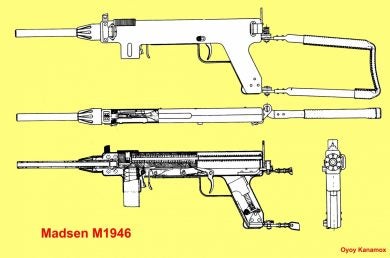
Schematic view of the early Madsen M1946. The cocking piece had downward, milled grip flanges on each side of the receiver for grasping when retracting the bolt to the firing position.
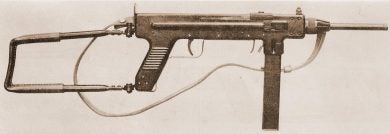
A standard production Madsen M1946. Note support ridge extending the right side length of the frame.
The story goes that Paes Barreto returned the SMG plans to the Madsen company shortly after the end of the war in Europe, the weapon quickly entering series production as the Model 1946 to replace a previous, but unsuccessful, Model 1945, soon followed by the basically similar Model 1950 and Model 1953. In brief, the design’s minimalism was mainly based on the fact the gun’s receiver comprised two nearly identical side sections of stamped sheet steel and which included the pistol grip and the magazine housing. The two frame sections were hinged at the rear, closing of the gun being carried out by the barrel mounting nut. The blowback-operated, full-auto-only (550/600 rpm cyclic rate of fire) Madsen was modest in terms of all parts used in its construction: under 40!
As a solid recognition to Paes Barreto’s help in preserving the subgun plans, the Danish factory officials found it proper to grant him free rights to manufacture the weapon in Brazil. As a Lt Colonel, the officer had been the Director of Brazilian Army’s Fábrica de Itajubá (Itajubá Factory), in Minas Gerais State, between September 1942, and February 1944, but had since gone to the Retired status in the rank of General. To carry out the project, a company called INA – Indústria Nacional de Armas S/A was created in Santo André, São Paulo State, in 1949.
As Brazil’s armed forces standard pistol caliber at the time was the .45 ACP, adopted with the country’s participation in WWII combat alongside the U.S. Fifth Army in Italy, the Madsen, originally in 9x19mm, was modified accordingly. Other changes introduced to what was basically an M1950 variant were the relocation of the reciprocating cocking piece (from a top-located knob to a right-side mounted hooked handle), the addition of a metal loop around the short magazine housing (to reinforce the joining of the two body halves), and minor changes in the front sight (from a protected blade to an unprotected post). It is reported that early design modifications were carried out at Fábrica de Itajubá under the supervision of a civilian armament engineer called Euclydes Bueno Filho, who would later join the INA concern as Technical Director. The modified gun was designated M.B.50 (Modelo Brasileiro 1950), is subsequently followed by the M.953, this featuring a longer magazine housing. Since official records have never been found (the factory closed in 1972), it is generally believed that total production may have ranged between 30,000 and as many as 80,000 examples, though the latter figure may be an overestimation.

A distinguishing feature of the later INA M.953 model as compared to the original M.B.50 was the longer magazine housing. The standard .45 ACP double-stack, the 30-round magazine was of the single-feed type, its loading tool being housed in the gun’s pistol grip.
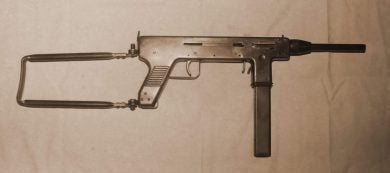
Right side view of the M.953 with the tubular metal stock extended.
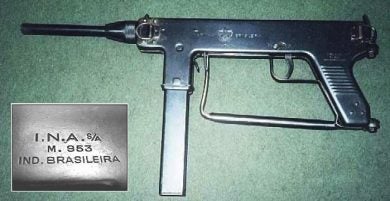
When folded to the right side, the stock’s butt plate lay exactly at the side of the grip safety lever, not allowing (apparently, intentionally!) the gun to be fired in this fashion. The inset shows typical markings of an M.953 manufactured by Indústria Nacional de Armas S/A.
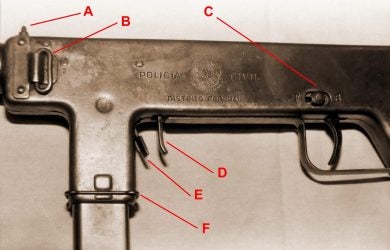
Details of an M.953 marked “POLÍCIA CIVIL – DISTRITO FEDERAL”: (A) unprotected post front sight; (B) forward sling loop; (C) “F” (Fire, forward) and “S” (Safe, rear) selector button; (D) grip safety lever; (E) pull-back, magazine release lever; (F) magazine housing fixation loop.
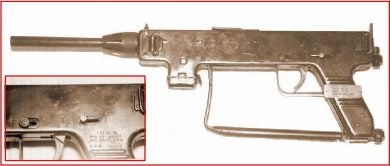
Rare photo of a Brazilian Air Force M.B.50 fitted with an also uncommon fire selector (“A”, Automatic, forward; “I”, Intermittent, rear) above the pistol grip. This is believed to be an optional Madsen feature added to some Brazilian INAs. A TFB exclusive, folks!

An idiosyncrasy of the original Madsen design was fully repeated in the INA: the recoil spring guide projected outward the receiver when the gun fired!
The INAs remained in local military (Army, Navy, Air Force) use until the early 1970s when the 9x19mm round was adopted as the standard and the Beretta M12 was adopted as the MtrM M1972. Many were transferred to police agencies nationwide, in which service where they could still be seen in the 1980s.
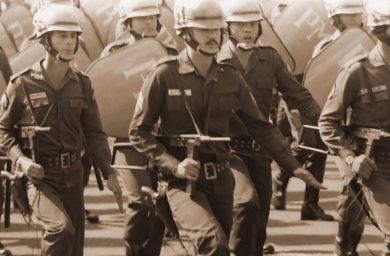

Following their phasing out of military service, the INAs found their way to many state LE agencies. These 1980 photos show M.953s in the hands of Rio de Janeiro State Military Police troops on parade (top picture) and Military firemen, who used them in guard and ceremonial duties.
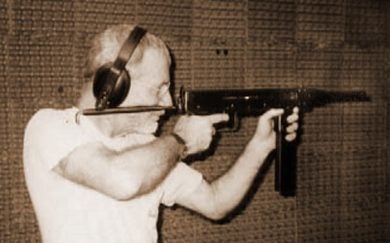
An old, low-quality photo of yours truly firing an M953 at an indoor range, somewhere in time…
BASIC INA M.B.50/M.953 SPECIFICATIONS:
Barrel length, 214mm; overall length, 793mm; length, stock folded, 545mm; weight (loaded 30-round magazine), 4.5kg.

Cover of an INA M.953 manual in Portuguese, dated 1954. Note that it was called “Metralhadora de Mão .45” (Handheld Machine Gun). The full PDF version is available below.
INA M953 manual (Portuguese, 1954)
Higher-res pics: https://imgur.com/a/opdMG
 Your Privacy Choices
Your Privacy Choices
